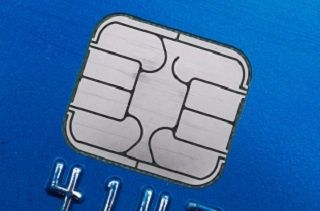You just received a chip credit card. Now, every time you go to a store, there is confusion over whether you insert or swipe your card. Why did credit card companies make a change to a system that was not broken? This blog will go through chip cards and the security they bring over magnetic swipe cards.
In recent years, chip cards have become the standard for credit and debit cards in many parts of the world. Chip cards are more secure than cards that solely use a magnetic stripe. Cards that use the EMV chip technology are harder for fraudsters to copy from in-person transactions. Magnetic stripe cards carry static data directly in the magnetic stripe. Fraudsters can copy your card easily with a skimmer, a tool typically added to gas stations and ATMs to steal cardholders’ information. Chip cards use a technology called dynamic authentication data element (ADe), which means that the chip in the card is constantly changing and updating, making it harder for criminals to hack into the card's information. Additionally, chip cards are encrypted, so it is much harder to copy. Fraudsters would have to physically manipulate the chip on the card to get your bank information.
Stopping Credit Card Fraud
The amount of credit card fraud and other forms of identity theft tops
$16 billion per year. Credit card issuers spend an average of $12.75 to replace each card reported stolen or part of a large-scale data breach.
While consumers rarely directly pay the costs of credit card fraud — the usual result is full reimbursement of the fraudulent charges and a replacement card issued for free — fraud protection comes at a hidden cost. Banks raise interest rates and annual fees to cover their losses. If merchants are not reimbursed for their losses by the bank, they will also raise prices.
Ending Counterfeit Transactions
One of the biggest sources of credit card fraud is counterfeit cards. Also known as cloning, this accounts for 37 percent of credit card fraud.
Thieves create counterfeit cards by stealing credit card numbers and expiration dates from consumers' credit cards. They then create their own card with your information and use it in stores. To get the information, they might hack into large databases or use skimming devices at places like gas pumps and vending machines.
The problem with magnetic strip cards is that this information is embedded right into the strip. Anyone with the right reader can take all your information off your card without you realizing what is happening until after it is too late.
With EMV chip cards, the information is still on your card but is scrambled. The chip creates a secret code that is constantly changing. Your credit card information is different for every transaction, so even if thieves scan your EMV card, they cannot use it without the chip.
Chip Cards Still Have PIN Verification for Extra Security
While it may seem an extra few seconds of inconvenience, in addition to the security provided by the chip, most chip debit cards require a personal identification number (PIN) for verification. This means that to make a purchase with some chip cards, the cardholder must enter their PIN into the card reader.
This adds an additional layer of security because it means that someone would not only have to have access to the physical card but also the correct PIN to make a purchase. This makes it much harder for fraudsters to use a stolen physical card along with skimming protection.
What About Counterfeit Cards?
One of the main advantages of chip cards is that they are much harder to counterfeit than magnetic strip cards. This is because chip cards generate a unique code for each transaction, known as a dynamic authentication data element (ADe). This code is created using complex algorithms and is difficult to replicate, making it nearly impossible for fraudsters to create a fake chip card.
On the other hand, magnetic strip cards store data in a static format, which means that the data on the strip is the same every time the card is used. This makes it relatively easy for fraudsters to create a fake card using stolen card information.
What About Places That Are Still Swiping?
Some merchants still have customers swipe their magnetic strips instead of inserting their chips. This eliminates the security benefits of the chip, but you do not need to worry. As a consumer, you still receive the full fraud protection of your credit card whether you use the magnetic strip or the EMV chip.
The only difference between swiped and inserted transactions is who covers the cost of fraud. Credit card issuers have traditionally covered fraud losses from their transaction fees and interest charges. Under the
EMV liability shift, the store now pays for fraud losses if they do not use an EMV chip reader to process transactions.
And while magnetic strip cards are still accepted at many retailers, chip cards are quickly becoming the standard for card payments. That means you will be able to use your chip card at a greater number of places, increasing the convenience and security of your payments.
What About Online Transactions?
Online transactions are largely unaffected by the new EMV chip technology. The online checkout process remains the same — you manually enter your credit card information.
What Should You Do?
The good news is you do not need to do anything. While you might experience some minor inconveniences in store checkout lines during the transition, your credit union and card issuers are working hard to protect you behind the scenes. You can use your credit card comfortably, knowing you still have full fraud protection.
This blog was initially posted in 2016 but was updated in 2023.
